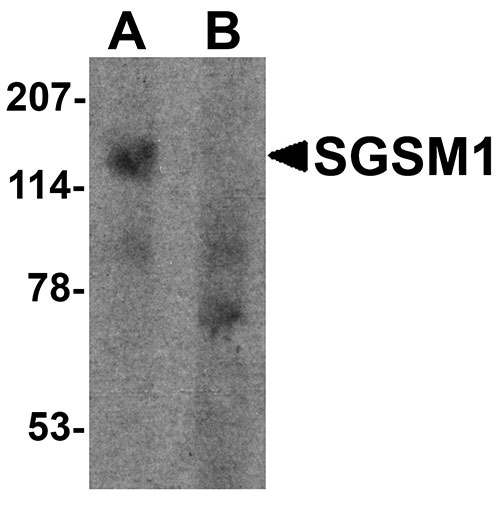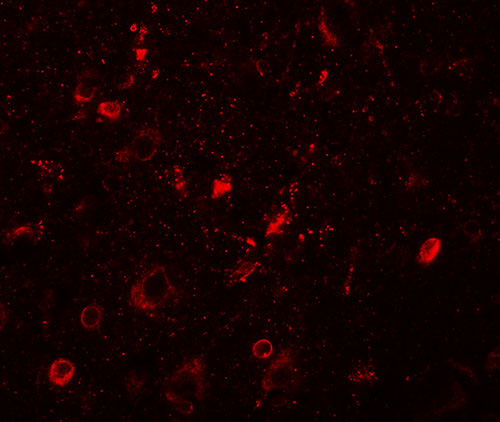SGSM1 Antibody
- 产品详情
- 实验流程
- 背景知识
Application
| WB, IF, E |
|---|---|
| Primary Accession | Q2NKQ1 |
| Other Accession | NP_001035037, 90577167 |
| Reactivity | Human, Mouse, Rat |
| Host | Rabbit |
| Clonality | Polyclonal |
| Isotype | IgG |
| Calculated MW | 129718 Da |
| Concentration (mg/ml) | 1 mg/mL |
| Conjugate | Unconjugated |
| Application Notes | SGSM1 antibody can be used for detection of SGSM1 by Western blot at 1 µg/mL. For immunofluorescence start at 20 µg/mL. |
| Gene ID | 129049 |
|---|---|
| Other Names | Small G protein signaling modulator 1, RUN and TBC1 domain-containing protein 2, SGSM1, KIAA1941, RUTBC2 |
| Target/Specificity | SGSM1; At least four isoforms of SGSM1 are known to exist; SGSM1 antibody will detect all four isoforms. |
| Reconstitution & Storage | SGSM1 antibody can be stored at 4℃ for three months and -20℃, stable for up to one year. As with all antibodies care should be taken to avoid repeated freeze thaw cycles. Antibodies should not be exposed to prolonged high temperatures. |
| Precautions | SGSM1 Antibody is for research use only and not for use in diagnostic or therapeutic procedures. |
| Name | SGSM1 |
|---|---|
| Synonyms | KIAA1941, RUTBC2 |
| Function | Interacts with numerous Rab family members, functioning as Rab effector for some, and as GTPase activator for others. Promotes GTP hydrolysis by RAB34 and RAB36. Probably functions as a GTPase effector with RAB9A and RAB9B; does not stimulate GTP hydrolysis with RAB9A and RAB9B. |
| Cellular Location | Golgi apparatus, trans-Golgi network {ECO:0000250|UniProtKB:Q8BPQ7}. Cytoplasmic vesicle membrane; Peripheral membrane protein. Cytoplasm Note=Recruited to cytoplasmic vesicle membranes via its interaction with Rab family members, such as RAB9A. |
| Tissue Location | Mainly expressed in brain, heart and testis. |
For Research Use Only. Not For Use In Diagnostic Procedures.
Provided below are standard protocols that you may find useful for product applications.
BACKGROUND
SGSM1 Antibody: Small G proteins such as RAP and RAB proteins are the key molecules in intracellular signal transduction and vesicle transportation. A novel protein family small G protein signaling modulator (SGSM) consisting of three members SGSM1-3 bind to RAP and RAB family proteins. All three SGSM proteins possess both a RUN domain and a TBC domain. SGSM1 (RUTBC2) is a 1,148 amino acid protein that localizes to the Golgi apparatus and is mainly expressed in the CNS. SGSM1 interacts with RAP and RAB subfamily members of the small G proteins, and function as modulators of RAP and RAB-mediated neuronal signal transduction and vesicular transportation pathways.
REFERENCES
Bar-Sagi D and Hall A. Ras and Rho GTPases: a family reunion. Cell 2000; 103:227-38.
Colicelli J. Human ras superfamily proteins and related GTPases. Sci. STKE 2004; 250:RE13.
Yang H, Sasaki T, Minoshima S, et al. Identification of three novel proteins (SGSM1, 2, 3) which modulate small G protein (RAP and RAB)-mediated signaling pathway. Genomics 2007; 90:249-60.
Williams JA, Chen X and Sabbatini ME. Small G proteins as key regulators of pancreatic digestive enzyme secretion. Am. J. Physiol. Endocrinol. Metab. 2009; 296:E405-14.
终于等到您。ABCEPTA(百远生物)抗体产品。
点击下方“我要评价 ”按钮提交您的反馈信息,您的反馈和评价是我们最宝贵的财富之一,
我们将在1-3个工作日内处理您的反馈信息。
如有疑问,联系:0512-88856768 tech-china@abcepta.com.























 癌症的基本特征包括细胞增殖、血管生成、迁移、凋亡逃避机制和细胞永生等。找到癌症发生过程中这些通路的关键标记物和对应的抗体用于检测至关重要。
癌症的基本特征包括细胞增殖、血管生成、迁移、凋亡逃避机制和细胞永生等。找到癌症发生过程中这些通路的关键标记物和对应的抗体用于检测至关重要。 为您推荐一个泛素化位点预测神器——泛素化分析工具,可以为您的蛋白的泛素化位点作出预测和评分。
为您推荐一个泛素化位点预测神器——泛素化分析工具,可以为您的蛋白的泛素化位点作出预测和评分。 细胞自噬受体图形绘图工具为你的蛋白的细胞受体结合位点作出预测和评分,识别结合到自噬通路中的蛋白是非常重要的,便于让我们理解自噬在正常生理、病理过程中的作用,如发育、细胞分化、神经退化性疾病、压力条件下、感染和癌症。
细胞自噬受体图形绘图工具为你的蛋白的细胞受体结合位点作出预测和评分,识别结合到自噬通路中的蛋白是非常重要的,便于让我们理解自噬在正常生理、病理过程中的作用,如发育、细胞分化、神经退化性疾病、压力条件下、感染和癌症。







